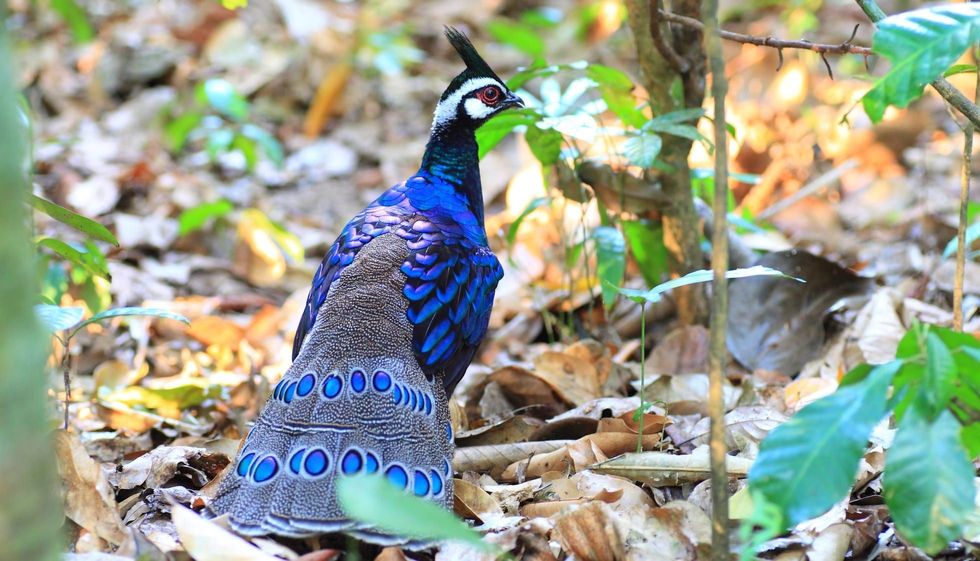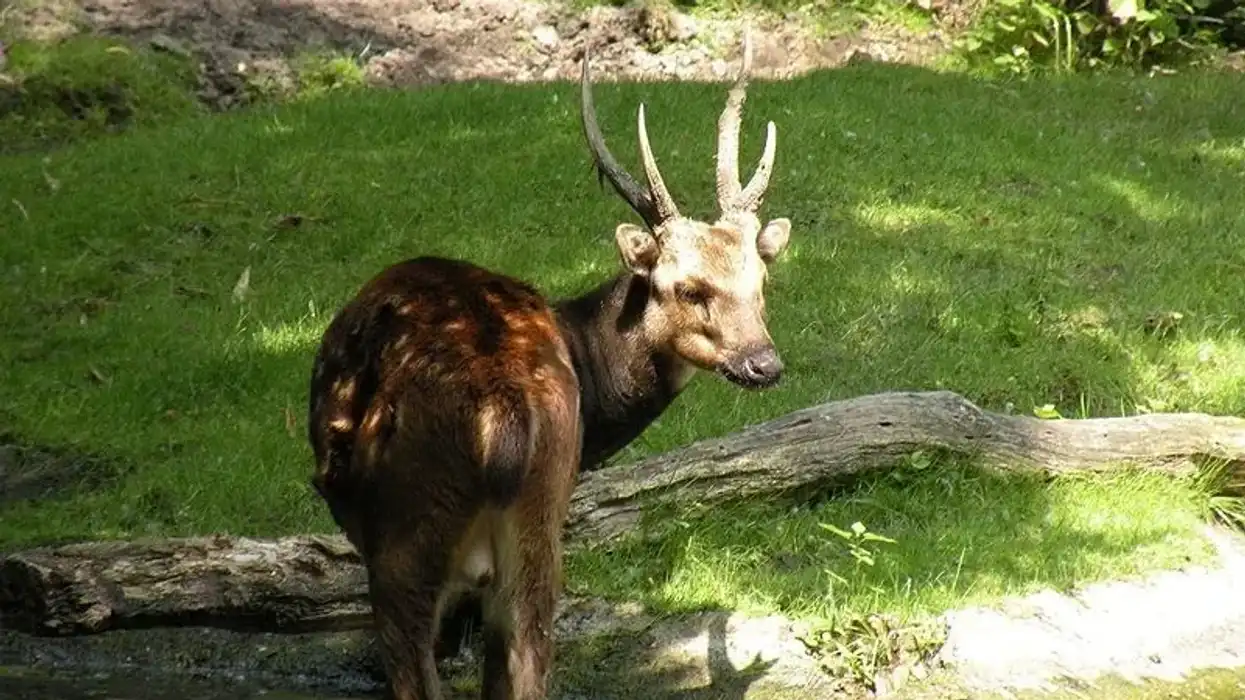If you are a fan of colorful birds, you will love reading about the tall Palawan peacock! It is considered to be one of the most beautiful animals on display with its deeply-hued wings and its strutting stride.
However, if you wish to see one of these colorful birds, you will have to travel all the way to the Philippines to the Palawan Islands, which is an archipelago of the small Asian country. Once there, you will be able to see these birds.
They are solitary for the most part but will be extremely dramatic and active in their breeding days. Males will woo females, and they will be mates for life.
Romantic, is it not? In addition, these two will also look after the eggs and babies equally until the babies age out and find themselves another partner.
If you wish to learn more interesting facts about this peacock, then read on! And if you are looking to know more facts about interesting and fun birds, then do not forget to check out birds like the great white pelican and the golden-cheeked warbler too.
Palawan Peacock Pheasant Interesting Facts
What type of animal is a Palawan peacock pheasant?
The Palawan peacock pheasant (Polyplectron napoleonis) is a type of peacock.
What class of animal does a Palawan peacock pheasant belong to?
The peacock pheasant (Polyplectron Napoleonis) is a type of bird belonging to the class Aves.
How many Palawan peacock pheasants are there in the world?
The medium-sized Palawan peacock pheasants are unique to the humid forests on Palawan Island, with a population of 20,000-50,000 birds.
Where does a Palawan peacock pheasant live?
The Palawan peacock pheasant (Polyplectron napoleonis) lives in the woods.
What is a Palawan peacock pheasant's habitat?
The Philippines are the only place on the planet where peacock pheasants may be found. The Palawan peacock pheasant's (Polyplectron napoleonis) habitat is in the moist coastal lowlands and thick humid forest of Palawan Island, the Philippines' southern archipelago.
Who do Palawan peacock pheasants live with?
Palawan peacock pheasant (Polyplectron napoleonis), which has its habitat in Palawan Island, is a solitary bird except for its mating periods.
How long does a Palawan peacock pheasant live?
The average lifespan of peacock pheasant (Polyplectron napoleonis) is up to 15 years in favorable conditions in the wild. The longevity range of Koklass pheasant, listed Least Concern by IUCN, is approximately 10 years in the wild.
How do they reproduce?
Males and females of this species partner for life, also stay together during the year. This male peacock of Palawan, under ideal conditions, will mate successfully during its second year, and the female would lay one or two cream-white eggs in a clutch.
Females begin to lay eggs in March and continue to do so until August. If the eggs are viable, the chicks may hatch after a 19-day incubation period. Both males and females are responsible for raising the chicks for up to two years.
What is their conservation status?
The Palawan peacock pheasants are classed as Vulnerable on the IUCN Red List of threatened creatures because of major habitat loss, the tiny size of the population, and the narrow range, as well as poaching and capture for commerce. Logging businesses are allowed to lease the wild habitat of these island Tandikan species.
As a consequence, the wild population continues to decrease. One more species of pheasant, the argus pheasant, is also considered a Vulnerable species by IUCN.
Palawan Peacock Pheasant Fun Facts
What do Palawan peacock pheasants look like?

The male bird has a beautiful green metallic crest and is quite attractive. This color slides alongside the neck and head, becoming blue as it progresses across the shoulders, wings, and tip of the breast.
On the chest and belly, the shine decreases to black, while the low back and tail feathers are beautifully patterned with small white patches on black. Tail feathers of mail are decorated with large blue-green ocelli, which may be spread fan-like in courtship display.
He has an erect crest, dark brown eyes encircled by red skin, and highly iridescence metallic green and black plumage. The male bird has a dark grey to black beak and dark gray legs.
The female is a fraction of an inch shorter than the male. Female contouring plumage has a hazy silty appearance.
Including an entire brown plumage, a small crest, and a pale throat, the female is significantly less striking. Chicks have a brown coloration with yellow streaks. During their first year, both male and female chicks look a lot like their mothers.
How cute are they?
The male bird is extremely beautiful and one of the cutest birds with a green metallic crest with a blue combination and stunning tail feathers.
How do they communicate?
During posture display behaviors, the male Palawan peacock pheasants bird excavates tiny depressions where it orients his body. The rectrices quills stridulate, causing the bird to vibrate noisily. This audio signal also functions as a sort of seismic interaction.
How big is a Palawan peacock pheasant?
The average length range of this island peacock pheasant species is about 19.68 in (50 cm). The length range of golden pheasant measures up to 35-41 in (90-104 cm), which much longer than the peacock pheasant.
How fast can a Palawan peacock pheasant fly?
The IUCN listed this bird species as Vulnerable, but they are excellent flyers. The flight of this Polyplectron Emphanum (peacock pheasants) is quick, direct, and long-lasting. There are no studies that have looked into its exact speed.
How much does a Palawan peacock pheasant weigh?
The birth weight range of medium-sized vulnerable bird species, peacock pheasant Palawan measures up to 11-15 oz (322-426 g).
What are the male and female names of the species?
In general, the peacock male is called a peacock, while the female is called a peahen.
What would you call a baby Palawan peacock pheasant?
They are called chicks.
What do they eat?
Highly insectivorous species, peacock pheasants mostly eat myriapods, isopods, insect larvae, spiders, earwigs, centipedes, mollusks, and termites. These birds also eat small frogs, lizards, baby snakes, drupes, seeds, and berries, among other things.
Are they dangerous?
This most gorgeous and exotic island bird (Polyplectron emphanum) has a conservation status listed as Vulnerable by the IUCN and is not a dangerous species.
Would they make a good pet?
Peacock pheasants are stunning birds that you may gaze at for hours! These species are produced for various reasons, the most important of which is the sale of eggs, meat, and feathers. Their colorful plumage also appeals to the eye. Any home will be enhanced by its presence.
Did you know...
The Palawan peacock-pheasant belongs to the Phasianidae family, is painted in a non-obtrusive manner, depending mainly on crypsis to escape detection. Peacock-pheasants use specialized plumage that, when extended, shows multiple iridescent orbs to change their shapes when attacked. The birds' plume quills quiver as well, emphasizing their aposematism. These birds are not migratory.
Is a peacock a pheasant?
Pheasants and peacocks are members of the same Phasianidae family as partridges (like the grey partridge), turkeys, and grouse. The peacock, referred to as Indian peafowl, as well as the pheasant, despite being in the same family, are different in color and size and reside in various regions of the world.
Palawan peacock pheasant is used as the official seal of which city?
This medium-sized peacock pheasant (Polyplectron emphanum) bird is portrayed in Puerto Princesa's official seal, which is located in the Philippines. This bird is a significant part of the Palawan native people's culture.
Here at Kidadl, we have carefully created lots of interesting family-friendly animal facts for everyone to discover! Learn more about some other birds from our night parrot facts and horned puffin facts pages.
You can even occupy yourself at home by coloring in one of our free printable Palawamn peacock coloring pages.










